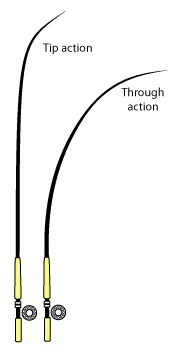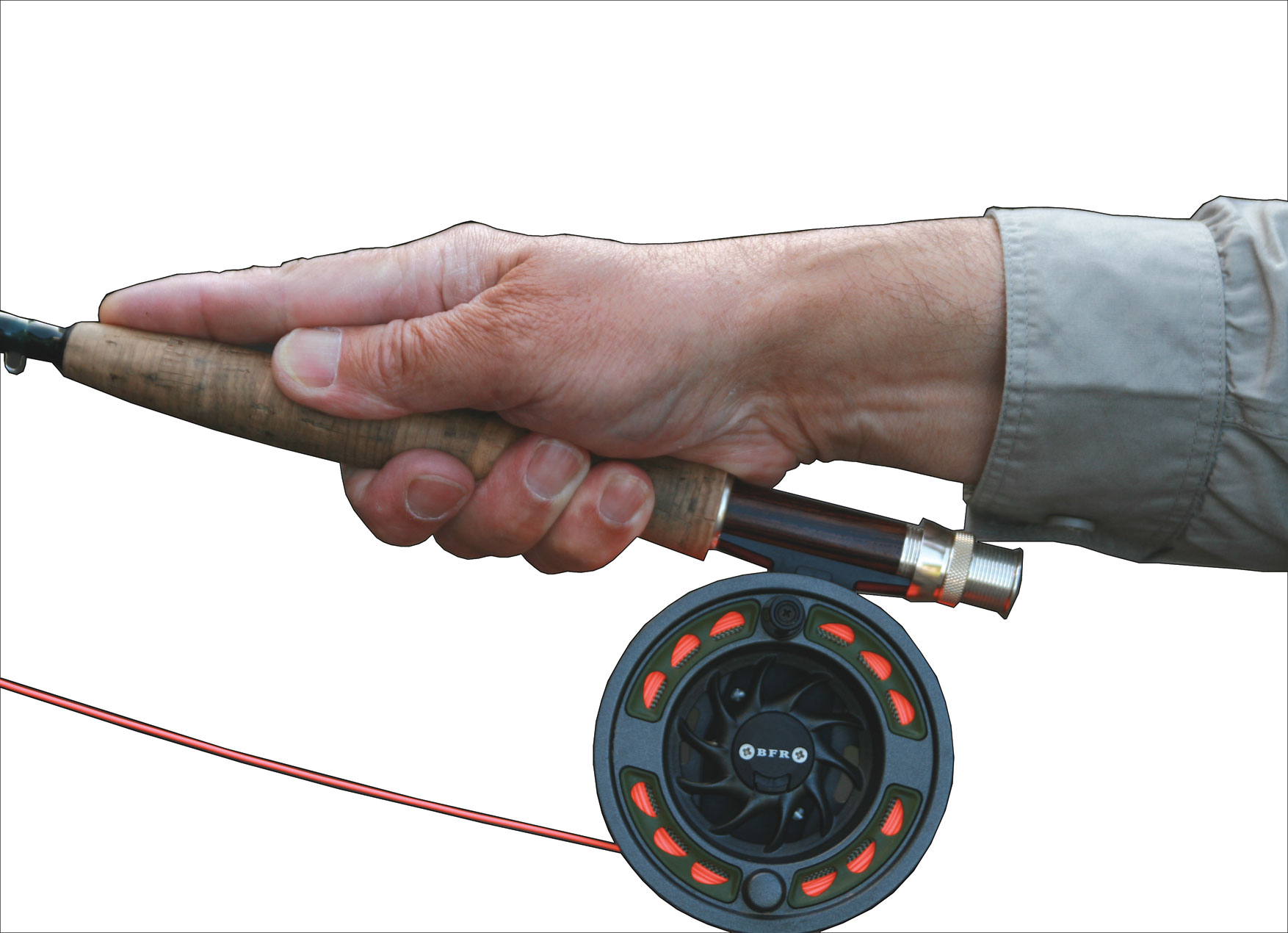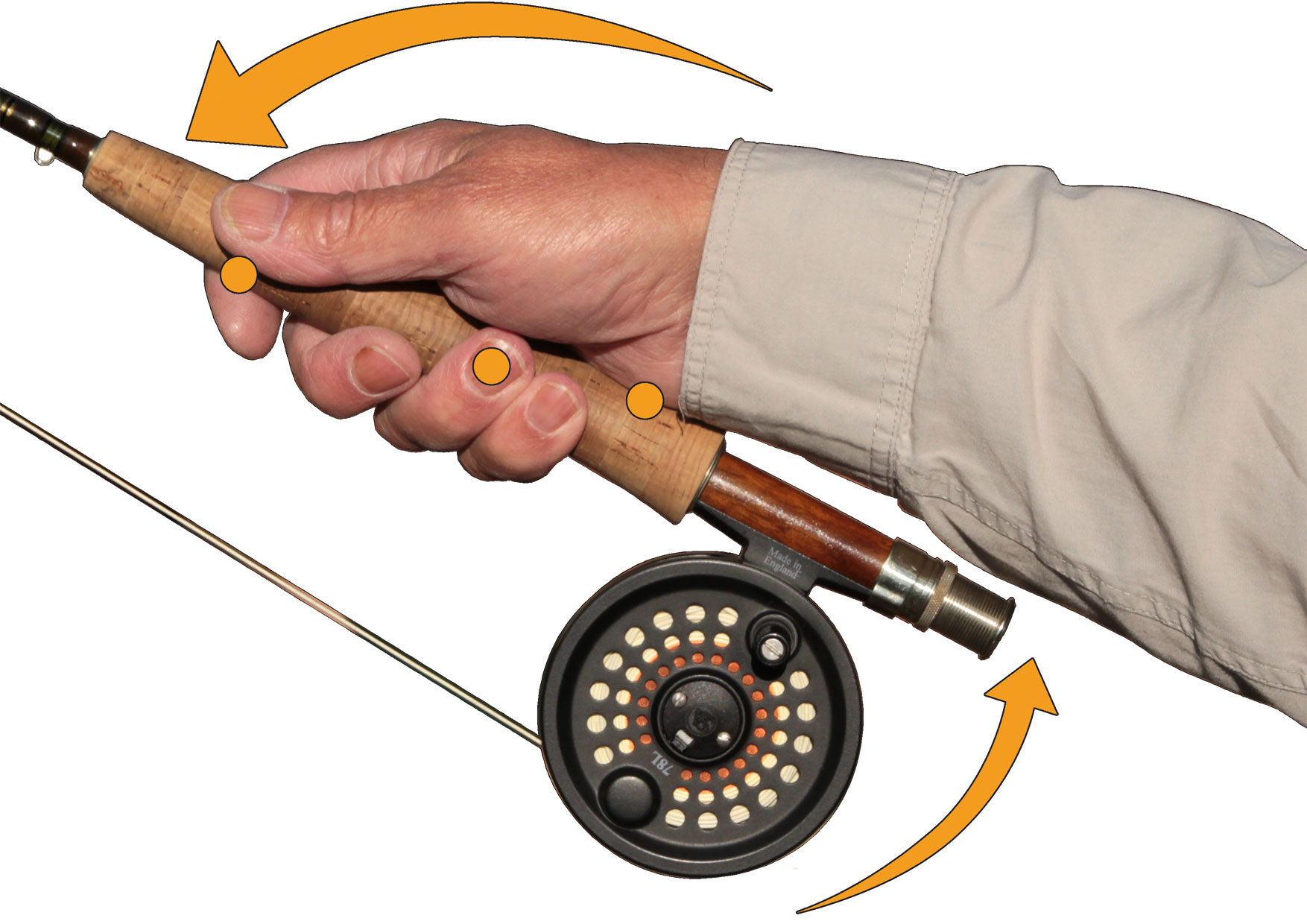Most fly fishers strive to cast with tight loops, sometimes over a long distance, and this is achieved by producing a high fly-line speed, which is determined by the rod-tip velocity and created by the ability of the fly-rod to store energy and to release this quickly at the end of the cast. Therefore, the fly-rod is required to continuously bend throughout the casting stroke and to recover to its normal straight position as soon as possible after the flexing has stopped. Both of these characteristics are determined by the taper of the fly-rod shaft and its modulus of elasticity; a fast taper and a high modulus will both produce a quick recovery.
The modulus is determined by the amount of carbon fibre used in the rod blank material and a higher modulus provides a greater resistance to bending and a quicker recovery from loading but ultimately there is a trade off of performance against the cost of a cloth with denser carbon weave and also the fly-rod is made more brittle as the amount of carbon is increased. Another way of increasing the carbon is to increase the wall thickness of the rod shaft but this makes the rod heavier and so again there is a compromise to be considered.
Rod action

The term action describes the manner in which a fly-rod bends when it is loaded and generally fast action rods are used for casting into high winds, or producing higher line speeds and because of this they usually cast further than slow action rods. A fast action rod flexes in the upper third of the rod, whilst slow action rod flexes in the upper two thirds and so consequently the latter are smoother to cast. Tip or fast action fly-rods work better with fly-lines that have a shorter body, requiring shorter casting strokes, such as shooting-heads whilst, conversely through or slow action fly-rods are a better choice for fly-lines with a longer body length and require longer casting strokes. The amount of flexing will determine the loop shape, whilst the stiffness of the butt section dictates the pace at which the fly-rod can be loaded and how quickly it unloads – the stiffer the butt section the quicker it will respond and recover. However, a stiffer fly-rod will not load and store energy so easily.
Fly-rod strength and length are dependent upon the type of fishing – generally larger fish, higher head-winds, bigger and heavier flies, or greater distances would all indicate the need for a longer and stronger fly-rod.
Fittings

Then there are practical considerations, including something that is easily overlooked, which is ease of portability. A four-piece fly-rod is easier to fit into the boot of a car or to transport on a plane, than a fly-rod with three sections. Expensive fly-rods do not improve casting-ability and are not necessarily the best value for money, whereas fly-rods which are sold at the lower end of the price scale may not be as durable or have such a good finish or be equipped with quality fittings.
For single-handed rods there is a choice of handle styles depending upon personal preference. A cigar-shaped handle is chosen for a delicate presentation, whereas a full or half-wells grip would be more suitable for power application.

Rod rings or guides are used to channel and support the fly-line along the rod-shaft to the rod-tip. Their main purpose is to allow the maximum amount of energy transfer to the fly-line. The first two rings are called stripper rings and these are used to smooth out the vibrations in the running line as it is pulled through the rings during shooting. They are fairly large rings, designed to give as little resistance as possible to line as it passes through at speed. The second ring up from the butt is normally smaller than the first.

Snake rings are the most commonly used for the remainder of the fly-rod, except the rod-tip. These have a double leg mounting and so whipping is required on both sides which stiffens up the fly-rod. Single leg rings are also available for when a faster response time is required. SiC (silicone carbide rings can also be used, these being the lightest, hardest wearing and the most expensive. Titanium rings are fitted to some fly-rods, which are also strong and hard wearing and the single leg mounting allows them to bend, thus providing protection against impact damage.
At the rod-tip a hay-fork ring is normally fitted.
Holding the fly-rod
Comfort is the most important consideration, when the fly-rod is used for several hours, therefore the fly-rod must be held in a relaxed manner whilst at rest and in action. The fly-rod should do all the work with the minimum input of effort from the caster.
Casting comprises two basic movements after the fly-line has been manipulated into the forward-casting position. There is a horizontal-stroke at the beginning of the cast followed by a rotation of the rod-handle, around an imaginary pivot-point. Therefore hand contact-points and position must accommodate these two requirements.
Gripping single-handed rods
 A number of grip styles that can be used with a single-handed rod. One of the most common is the thumb-on-top method. Pressure is applied through the thumb to create powerful rod-rotation. The drawback with this grip is that in the open-stance casting position, which is used for longer casting techniques, the hand is naturally turned, when the thumb is on top and so this causes the wrist to twist during the forward- cast and this invariably introduces tracking problems.
A number of grip styles that can be used with a single-handed rod. One of the most common is the thumb-on-top method. Pressure is applied through the thumb to create powerful rod-rotation. The drawback with this grip is that in the open-stance casting position, which is used for longer casting techniques, the hand is naturally turned, when the thumb is on top and so this causes the wrist to twist during the forward- cast and this invariably introduces tracking problems.
 Another method employs the index finger on top, which helps to prevent wrist-break.
Another method employs the index finger on top, which helps to prevent wrist-break.
The problem with this method is that both rod-rotation and the casting-stroke become inhibited and so it is limited to short-distance casting.
Three-point contact is one of the most efficient grips because this allows unimpaired and controlled movement during the casting-stroke and rod-rotation phases.
The rod can be easily held loosely in the hand and simply allowed to snap forward under its own weight during rod-rotation.
Whilst the three-point contact grip is less natural it does offer a number of advantages. The other grips mentioned may be preferred by the caster if they are comfortable and fulfil the requirements of the casting style.
Whatever grip is selected it has to be relaxed, comfortable and allow rotation of the wrist to provide loop control. It also has to enable long horizontal-strokes to be made without turning the hand and fly-rod. The grip should be loose (like holding a small bird), allowing the rod to move, except at the end of the stroke when a crisper stop can be achieved by squeezing the hand.

The picture shows how the ball of the palm sits right over the fly-reel and so provides maximum casting leverage. It also helps to negate any weight of the fly-reel, even though this is probably insignificant considering the other forces acting on the fly-rod. Alternatively the ball of the hand could rest in the well of the rod-grip. This is a question of style.
The front two contact-points are used for rotating the rod during the forward-cast, whilst the back contact point provides a stop, thus preventing excessive wrist rotation. The outer two contact-points are used during the back-cast.
Under no circumstances should the wrist be allowed to flop or break because this will dampen the energy that is stored in the fly-rod.
Gripping the double-handed rod

The hands should be positioned with a comfortable spacing between them, which can be determined by holding the fly rod down in the relaxed position, with the arms extended and touching the side of the body. Where the hands rest naturally is usually the best position for them. If the hands are too close together this will create too much leverage and hence excessive strain on the hands and arms, so there is a comfortable compromise. The closer the hands are together the more and faster the rod-tip moves in response to hand movements and so sometimes, close-together hand positions are desirable for manipulating the fly-rod and line, and achieving longer casting-strokes and a tight forward-loop through faster rod-rotation. This is particularly helpful for roll-casting or in Scandinavian style casting when shooting-heads are used, for example.
There is a tendency for newcomers to Spey casting to use more upper hand than lower hand, particularly for those that have previously used a single-handed rod. The forward cast technique employs a horizontal casting stroke, followed by the rotation of both hands and approximately 50% of the power is provided by each one. Although in some circumstances more bottom hand is used, for example when tighter loops are required for casting into a strong wind or over a long distance.
Furthermore, beginners tend to reach out with all of both arms, making unnecessary use of the upper arms, making it more difficult to maintain control the fly-rod, especially during rod-rotation and the controlled stop at the end of the forward-cast sequence.
It is important to note that most of the fly-rod movement is achieved by moving the hands and forearms and that the elbows are kept close into the body, although raised slightly at the end of the back-cast where they are held in readiness for the forward-cast.